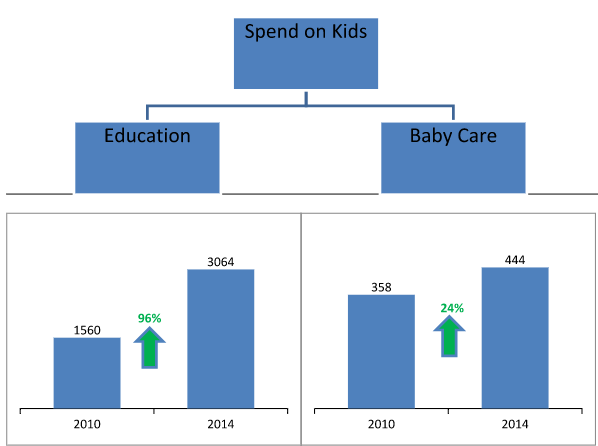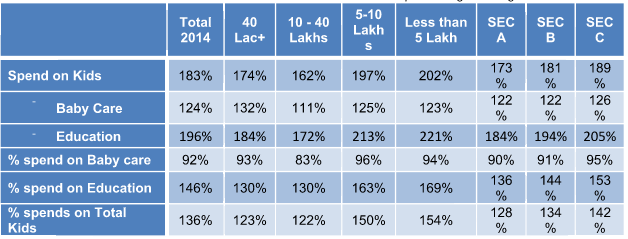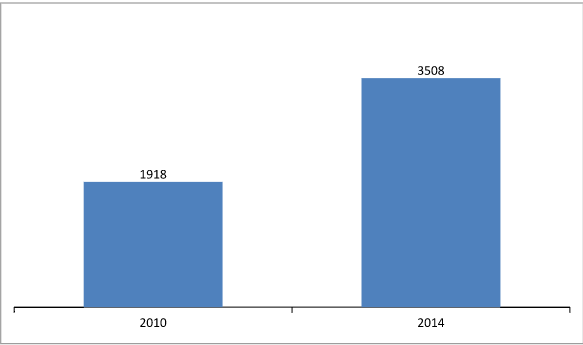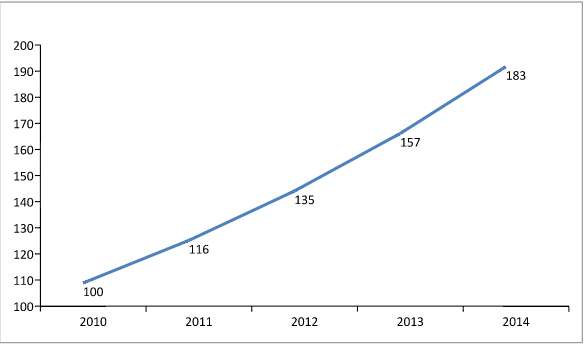Case Study
Growth in Spends on Kids
What is driving this growth?
Spend on kids constitutes of two heads:

- Since 2010 spend on kids has seen a phenomenal growth of 83%. Education which
- was 3 rd , in the hierarchy of spend in 2010 with 12% share, has moved up to secure 2nd place in 2014 with 14% share of wallet
- Growth in spends on kids is driven by Education, which has almost doubled its expenses since 2010
Where is the change happening?
- This rise in spends on kids is seen to be higher in small towns, there was an 102% rise in Less than 5 lakh towns as compared to 74% rise in 40 lakh+ towns. Also, the growth in spends is higher among SEC C (89%) as compared SEC A (73%) Within spend on kids; Education has a faster growth rate as compared to baby care.
- In case of education as well, it is seen that smaller towns and SEC C have outperformed larger towns and SEC A respectively

- At an overall level the share of spends on kids has seen a growth of 36%, wherein education has a 46% rise in its share. Baby care as a category has seen a drop in its share from 2010; this drop is steeper in larger towns and SEC A. Though in absolute terms there is a growth but the category has failed to defend its share in the wallet
- A closer look into Baby care category reveals that Baby foods as a category has dropped across town class and SEC
- As per IMRB’s syndicated study TGI, baby foods have seen a marginal drop of 2% since 2010; this is seen to be driven by larger towns

- It is also observed that other categories in Baby care have seen a growth in spends.
- Oils have a higher growth in small towns, whereas diapers are a big town phenomenon
What this means? - Changing trends in Country
Spends on Kids has seen a higher growth in smaller towns, this is mainly led by phenomenal rise in spends on Education. This change when looked through the lens of TGI, IMRB’s syndicated profiling study, it reveals shifts in the outlook that people in small towns have towards education.
Those who’s kids are perusing higher education in less than 5 lakh towns has seen a growth of 15% since 2010. Even in SEC C this number has grown by 14%. Also, the kids studying in vernacular language has dropped by 10% in the same time period.
Parents in these towns who have opted for international bachelorate curriculum for their kids have jumped by 36% (from 2010); SEC C has also recorded a growth of 12%. Parents are these days using internet for accessing parenting content which has seen a rise of 151% (although on a smaller base) since 2010 in less than 5 lakh towns.
Attitudinally parents’ agreeing to ‘I would like my children to be ahead of others even if it means a lot of pressure’ has grown by 20%, whereas agreement to ‘Children should be allowed to express themselves freely’ has dropped by 9% (Top two box score, since 2010 for less than 5 lakh towns). Similar trends were seen in lower SEC.
Today, the mind-set of parents is fiercely competitive; they want their children to give their best and be ahead of others. This also means that they set the rules and would not like the kids to express themselves freely. Parents are also giving their attention and time to kids – as per TGI they are spending 8% more (compared to 2010) time caring for their kids in an average week.
Parents these days prefer to have lesser number of kids and give them quality upbringing. This is evident from IMRB’s study TGI, according to which the number of household with 3+ kids has dropped by 22% since 2010.
These factors are cumulatively responsible for the growth seen in spends on kids.
DOWNLOAD
